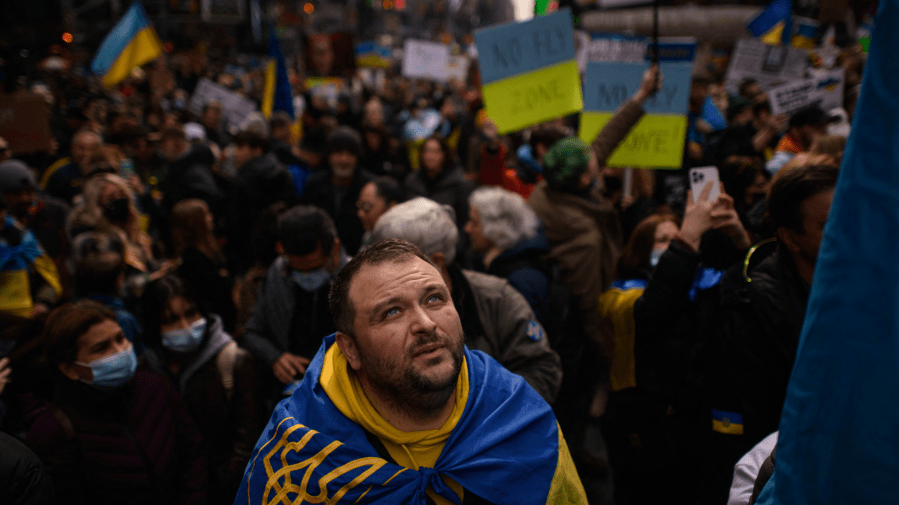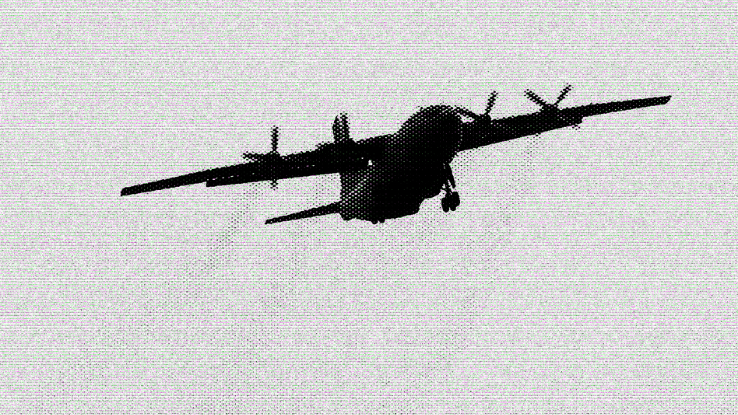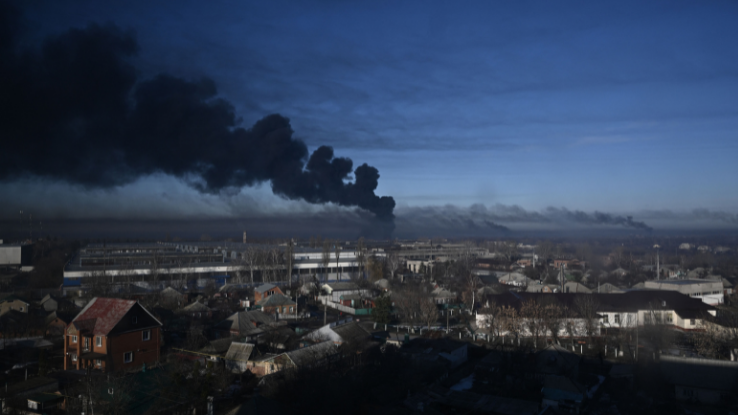What Is a “No-Fly Zone” — and Is This How NATO Can Help Ukraine?

President Volodymyr Zelenskyy of Ukraine has called for NATO’s (the North Atlantic Treaty Organization) support when it comes to closing the airspace over his country. Even amid President Vladimir Putin’s ongoing airstrikes, President Joe Biden, and other officials in the United States government and abroad, remain hesitant, fearing a NATO-imposed no-fly zone could be seen as an act of aggression that would potentially bring other nations more directly into the war.
Putin has recently increased Russia’s aerial assaults on Ukraine, claiming his military has established air superiority in the region. Ukraine denies that assertion. So far, rather than declare a military no-fly zone over the country, the U.S. and its NATO allies have sent thousands of man-portable air-defense systems, known as MANPADS, to Ukraine. These surface-to-air missiles can be fired from the ground at low-flying aircraft, but Zelenskyy has insisted a military no-fly zone would be more helpful when it comes to protecting Ukrainian citizens who are caught in the crossfire.
Currently, mandating a military no-fly zone is still an option. For Ukraine, seeking help from NATO, and being able to supplement its air defenses, seems like the best route for keeping Ukranians safe. Before we look at the pros and cons associated with a NATO-imposed no-fly zone, let’s look at the history of this strategy. To start, what exactly is a military no-fly zone?
What Is a Military No-fly Zone?
A no-fly zone is a designated area where aircraft are prohibited from flying. Military no-fly zones are sometimes used in areas where wars, or military conflicts, are occurring in order to stop a foreign country from flying over said area(s). Most often, the goals imposing a no-fly zone are two-fold: this strategy can prevent attacks on important targets and/or civilians, and it can stymie an opposing military’s surveillance.
How Does a No-fly Zone Work?
In no-fly zones, fighter jets will typically patrol the area to keep an eye out for any aircraft that’s violating the terms of the no-fly zone. No-fly zones serve as a warning to anyone violating the off-limits air space. Any aircraft entering the no-fly zone will be escorted out of the area — or face being shot down for not complying.
What Areas Are No-fly Zones?
No-fly zones are also used in other areas to protect certain governmental, religious, and historical sites. For example, there are no-fly zones surrounding the following places:
- Areas within Washington, D.C., including near the Capitol Building and the White House
- Certain sites in London, such as the home of the U.K.’s Prime Minister on Downing Street, the Houses of Parliament and Buckingham Palace
- Machu Picchu in Peru’s Andes Mountains and the Parthenon in Athens, Greece
- Mecca in western Saudi Arabia
- Disneyland in Anaheim, California and Walt Disney World in Orlando, Florida

However, military no-fly zones are also often used in active war zones or areas enveloped in conflict. Some examples include:
Libya (2011, 2018 & 2019)
The United Nations (UN) enacted a no-fly zone in 2011 to prevent attacks on civilian targets. The Libyan National Army declared a no-fly zone in 2018, and then for 10 days in 2019 as well.
Iraq (1991–2003)
The U.S. and other nations established two no-fly zones over Iraq to prevent attacks by the Iraqi regime of Saddam Hussein against the Kurdish and Shia populations. This was done in response to the Iraqi Air Force’s use of chemical weapons against the Kurdish people, which killed some 5,000 civilians.
Bosnia and Herzegovina (1993–1995)
In 1993, the UN Security Council authorized a no-fly zone over Bosnia. NATO forces patrolled the area but did not take any action against violators.
Is a No-Fly Zone in Ukraine a Good Idea?
In an emotional appeal to Congress in March 2022, Zelenskyy said Russia, “has turned the Ukrainian sky into a source of death for thousands of people.” Estonia, which shares a border with Russia, passed a resolution the same month, also calling for the establishment of a no-fly zone above Ukraine.
Establishing a no-fly zone would commit U.S. and NATO forces to sending jets to patrol Ukrainian air space and take military action against those — including shooting down Russian military aircraft — that violate the no-fly zone(s).
Biden and the leaders of other ally nations have since rejected the idea, taking the position that a no-fly zone supported by NATO forces would escalate the situation, drawing the U.S. and NATO into direct military combat with Russia. “We will not fight a war against Russia in Ukraine,” Biden said. “Direct confrontation between NATO and Russia is World War III, something we must strive to prevent.”

A no-fly zone over Ukraine would be significantly different than previous no-fly zones established over places such as Libya and Iraq; these nations, which dealt primarily with in-country conflicts, did not boast the same kind of military force as the U.S. and Russia. That is, the Russian air force is one of the largest in the world, second only to that of the U.S. in size.
“To anyone who would consider interfering from the outside: If you do, you will face consequences greater than any you have faced in history,” Putin declared. “I hope you hear me.”
Calls for a Limited No-Fly Zone Over Ukraine
Some experts, including a former Supreme Allied Commander of NATO, have called for a limited no-fly zone. This would serve to protect areas in Ukraine where refugees are being evacuated to and to where organizations are delivering humanitarian aid.
Politico published an open letter signed by 27 individuals, including former U.S. ambassadors, former administration officials, and former U.S. Army Commanding Generals, urging the use of a limited no-fly zone.
U.S. Citizens and Experts Disagree on a No-Fly Zone Over Ukraine
A Reuters poll showed U.S. citizens are broadly in favor of establishing a no-fly zone. Nearly three-quarters (74%) of those surveyed support U.S. and NATO imposing a no-fly zone over Ukraine. The move is even popular across party lines with a majority of Republicans and Democrats supporting the action.
International relations experts surveyed by the Teaching, Research, and International Policy (TRIP) Project at William & Mary’s Global Research Institute disagree, however. Those surveyed expressed nearly unanimous opposition to no-fly zones, fearing an escalation of the conflict — including the heightened potential for Russia to launch nuclear attacks. Moreover, 93% of the international relations experts expressed concerns, preferring to support other administration policies, such as:
- Continued sanctions against Russia
- Taking in Ukrainian refugees
- Sending military supplies to Ukraine
- Banning oil and gas purchases from Russian sources
- Deployment of NATO forces to nearby NATO nations
Those surveyed estimate that the establishment of a no-fly zone would triple the odds of a military confrontation between Russia and NATO, and double the risk of Russia using a nuclear attack against a NATO country.Even if NATO imposed a no-fly zone, all of Russia’s aerial assaults on Ukraine wouldn’t stop.
Although some of the aerial assaults on Ukraine have been initiated by entering Ukraine’s air space briefly, many of Putin’s attacks on Ukraine have been launched from outside Ukrainian airspace using long-range bombers and cruise missiles launched from both Russia and Belarus. For now, the use of a no-fly zone over Ukraine remains up for debate.





